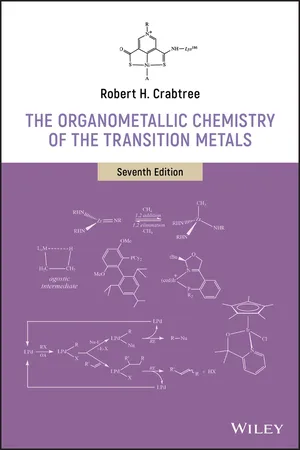
- English
- ePUB (mobile friendly)
- Available on iOS & Android
The Organometallic Chemistry of the Transition Metals
About this book
Provides vital information on organometallic compounds, their preparation, and use in synthesis, and explores the fundamentals of the field and its modern applications
Fully updated and expanded to reflect recent advances, the new, seventh edition of this bestselling text presents students and professional chemists with a comprehensive introduction to the principles and general properties of organometallic compounds, as well as including practical information on reaction mechanisms and detailed descriptions of contemporary applications. Increased focus is given to organic synthesis applications, nanoparticle science, and green chemistry. This edition features up-to-date examples of fundamental reaction steps and greater emphasis on key topics like oxidation catalysis, CH functionalization, nanoclusters and nanoparticles, and green chemistry. New coverage is added for computational chemistry, energy production, and biochemical aspects of organometallic chemistry.
The Organometallic Chemistry of the Transition Metals, Seventh Edition provides new/enhanced chapter coverage of ligand-assisted additions and eliminations; proton-coupled electron transfer; surface, supported, and cooperative catalysis; green, energy, and materials applications; and photoredox catalysis. It covers coordination chemistry; alkyls and hydrides; Pi-complexes; and oxidative addition and reductive elimination. The book also features sections on insertion and elimination; spectroscopy; metathesis polymerization and bond activation; and more.
- Provides an excellent foundation of the fundamentals of organometallic chemistry
- Includes end-of-chapter problems and their solutions
- Expands and includes up-to-date examples of fundamental reaction steps and focuses on important topics such as oxidation catalysis, CH functionalization, nanoparticles, and green chemistry
- Features all new coverage for computational chemistry, energy production, and biochemical aspects of organometallic chemistry
The Organometallic Chemistry of the Transition Metals, Seventh Edition is an insightful book that will appeal to all advanced undergraduate and graduate students in organic chemistry, organometallic chemistry, inorganic chemistry, and bioinorganic chemistry, as well as any practicing chemist in those fields.
Frequently asked questions
- Essential is ideal for learners and professionals who enjoy exploring a wide range of subjects. Access the Essential Library with 800,000+ trusted titles and best-sellers across business, personal growth, and the humanities. Includes unlimited reading time and Standard Read Aloud voice.
- Complete: Perfect for advanced learners and researchers needing full, unrestricted access. Unlock 1.4M+ books across hundreds of subjects, including academic and specialized titles. The Complete Plan also includes advanced features like Premium Read Aloud and Research Assistant.
Please note we cannot support devices running on iOS 13 and Android 7 or earlier. Learn more about using the app.
Information
1
Introduction
1.1 Why Study Organometallic Chemistry?
In 1989, OMCOS‐VI [the 6th International Conference on Organometallic Chemistry Directed Toward Organic Synthesis] took place in Florence and … left me with the impression that all important transformations could – now or in the future – be performed with the aid of adequately fine‐tuned metal catalysts. Today, it is safe to say that those early findings were key discoveries for a conceptual revolution that occurred in organic chemistry in recent years. Metal catalysts can be found everywhere, and many synthetic advances are directly linked to … developments in catalytic chemistry.
Table of contents
- Cover
- Table of Contents
- Preface
- Acknowledgments
- List of Abbreviations
- 1 Introduction
- 2 Making Sense of Organometallics
- 3 Alkyls and Hydrides
- 4 Ligand Substitution
- 5 Pi Complexes
- 6 Oxidative Addition and Reductive Elimination
- 7 Insertion and Elimination
- 8 Addition and Abstraction
- 9 Homogeneous Catalysis
- 10 Physical Methods
- 11 M-L Multiple Bonds
- 12 Metathesis, Polymerization, and Bond Activation
- 13 Green Energy and Materials Applications
- 14 Organic Applications
- 15 Paramagnetic and High‐Oxidation‐State Complexes
- 16 Bioorganometallic Chemistry
- Appendix A: Useful Texts on Allied Topics
- Appendix B: Major Reaction Types
- Solutions to Problems
- Index
- End User License Agreement